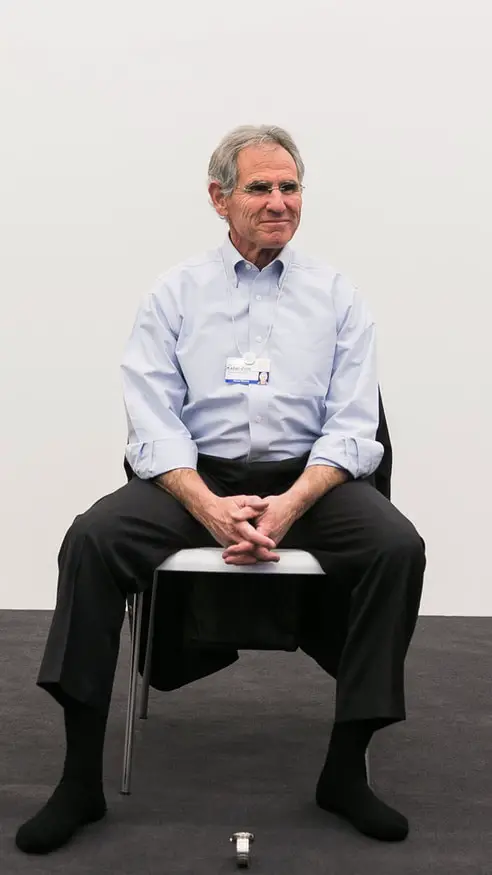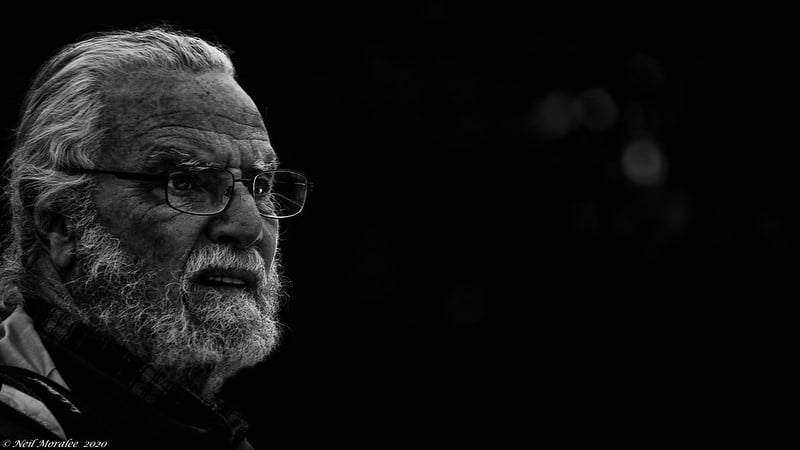An In-depth Look at the Definition of Mindfulness from Jon Kabat-Zinn
There are a lot of definitions of what mindfulness exactly is out there. But the most widespread is the one given by Jon Kabat-Zinn.
His definition is as follows:
Mindfulness is awareness that arises through paying attention, on purpose, in the present moment, non-judgmentally. Mindfulness is used in the service of self-understanding and wisdom.
This is a great definition that contains a lot of hidden wisdom in it. If you follow along, I’ll unpack it for you so that it becomes a beautiful and practical tool for self-realization and increased well-being.
- Mindfulness is awareness
- Mindfulness is about paying attention, on purpose
- Mindfulness is about the present moment
- Mindfulness is non-judgmental
- Mindfulness is used in the service of self-understanding and wisdom.
- Mindfulness is not about ‘not thinking’
- Further study of mindfulness
- Jon Kabat-Zinn Explains Mindfulness Himself
Mindfulness is awareness

When people first attend a mindfulness class they sometimes have a preconceived notion that mindfulness is some special state of mind that only monks living in caves can attain.
But the truth is that mindfulness is simply being aware of what is happening. So there is nothing mystical about this. Being aware of things is something very mundane.
Now, we’ll see that when applying the full definition of mindfulness as Jon Kabat-Zinn gives it, it becomes a little more involved and because of this, we might indeed experience states we are not used to.
But these are states of happiness and well-being. Nothing extraordinary.
But we are getting ahead of ourselves.
Mindfulness is simple awareness. So you can do the following little exercise to have your first experience of mindfulness:
Exercise: Just become aware of your surroundings. Look around and notice your screen. Look around and see the walls of your room. Or if you are sitting outside reading this text on your mobile, see the trees or the cars.
You can maybe feel yourself sitting down, or standing in the subway. Wherever you are, whatever you do, get your senses involved and be aware of whatever is presenting itself to your senses.
Do this exercise for 30 seconds.
Congratulation, you have just had your first taste of mindfulness!
Mindfulness is about paying attention, on purpose

Jon continues his definition of mindfulness by saying we need to pay attention, on purpose.
In this little addition, he tackles one of the great misunderstandings of mindfulness. People often think that is very passive.
On the contrary, mindfulness is a very engaging way of being in the world. We need to pay attention to whatever is coming our way. it is not just impressions that are hitting our senses, no, we engage with those impressions and we notice them.
We learn to really notice them.
This is an especially great skill when talking to people. Sometimes, when people talk to me, I get distracted. I hear what they are saying, but I am not really listening to what they are telling me.
That is not mindfulness.
Mindfulness is choosing where you put your attention on and keeping it there, on purpose. So it is you who decides consciously.
This is to counter our constant state of distractedness. The first thing people notice when they start meditating is as soon as they try to focus on the breath, they get distracted.
So in mindfulness, we choose our object of concentration on purpose and then we pay attention to how it unfolds. We listen, see, smell, or feel with attention.
Exercise: Again, become aware of your surroundings. But now we will willfully direct our attention to hearing. Listen very attentively to all the sounds around you. If you are in a loud environment, first let in all the sounds. Just let everything in.
Now, select out one particular sound that for some reason stands out for you. Just listen to this sound and do it with your full attention.
If you are in a place with almost no sounds, prick up your ears, and become very attentive. Maybe there is a sound in the distance you can pick up. And if there is really no sound, listen to your breathing. Usually, this is audible.
Do this exercise for 1 minute.
Mindfulness is about the present moment
Did you also have this experience when you head off to someplace with your car or by foot via a way that is very familiar to you? And then when you are almost there, you reflect back on the trip and you haven’t got the slightest idea of how you got there?
I’m sure you do.
Well, how did you get there? Your body clearly knew the way since you got to your destination.
But where was your conscious mind? It clearly was not making the trip with you since you cannot remember how you got there.
Chances are you spend a great deal of the trip daydreaming. You were either reflecting on something that happened in the past or you were considering something that still needs to happen in the future.
Those are the 2 places where our minds dwell most of the time: either in the past or in the future.
Seldom are we focusing on the present moment.
Just to reassure you, the present moment is not some new-age invention. It just means whatever is happening now. Nothing more, nothing less. So if you are drinking tea right now, this is the present moment for you.
But it is this fundamental tendency of our minds that makes that we are distracted when people talk to us. We are so habituated of not being present that it takes quite some energy to finally pay attention.
Exercise: The previous exercises have always been rather short, but not this one. For this one, you should take 5 minutes in order to see the effect.
From the previous exercises, you might already have some preference for which sense you want to be mindful of; Just go with this one and repeat the exercise as described.
But since this exercise is now longer, your mind will start to drift. It will either escape to the future or return to the past.
Be on the lookout for when the mind does this and when you notice it, gently bring your attention back (on purpose) towards your chosen object.
If you want to take the exercise one step further, you can notice where your mind was when it drifted away. Was it in the past or the future? By doing so, we can learn a great deal about the habitual operation of our minds.
Mindfulness is non-judgmental

Mindfulness is, in a way, a means of gathering facts. Facts about your life. Facts about how we give ourselves a hard time and facts about the great things that happen in our lives.
What we try to do accomplish with mindfulness is to look to the present moment in an objective way.
In order to do this, we need to momentarily suspend our preconceived notions about how we think things are or how we think things should be.
We look at the facts of life like we were a scientist.
I especially use the image of the scientist because we might think that by being non-judgemental we stop our common sense.
That is absolutely untrue. We need to make powerful decisions. But we need to make them based on facts and not on how we think the world works.
That is the key difference.
I always like to quote the serenity prayer in this context:
May I have the serenity to accept the things I cannot change,
Reinhold Niebuhr
The courage to change the things I can,
And wisdom to know the difference
So mindfulness will not make us wimps. Usually, it is quite the contrary. A friend of mine worded it very beautifully: ‘With meditation, one becomes more oneself’. What he meant by that, was that is we grow in meditation, we learn to stick up for ourselves and become more courageous.
And, I might add, we get a much more realistic view of who we really are in the process.
Exercise: The exercise for this last part of the definition, is the same as the previous one, but with a twist.
Again take 5 minutes to focus exclusively on one of your senses. And when the mind disengages, as before, you bring it gently back to the sense you agreed upon.
But this time around, be on the lookout for subtle judgments about the experience. These might be positive or negative.
Aa an example, you might get annoyed because you still cannot get your mind to focus for 5 short minutes. You might think that you are really bad at mindfulness.
For the records, if you manage to not be distracted for the full 5 minutes, you are truly gifted. In the beginning, I was lucky if I could do it for 1 minute at the time.
So that is a clear example of some judgment that springs to our mind that is clearly wrong. You are in the same boat as everybody else, but our mind wants us to believe differently.
Mindfulness is used in the service of self-understanding and wisdom.

This last part of the operational definition of mindfulness as given by Jon Kabat-Zinn is not operational as the other sections we have discussed. It explains why mindfulness is used.
I already touched on this subject in the previous sections, but we use mindfulness to improve our lives.
How do we do that?
By learning about the good things in our lives and the bad things in our lives. We look at them and then we learn from them. Through mindfulness, we have a much clearer view of what is operating in our lives and are able to view this with more calm.
Through mindfulness, we also learn what makes us tick. And since we also learn to look at the facts in a non-judgemental way, we will also start to see through the situation. In this way, it will affect us much less.
The wisdom part to which is referred is an experiential knowledge of the how the world operates and the positive strategies we can adopt to increase our wellbeing.
This includes the fact that there are ups and downs in life and that, for the most part, we are able to cope with them. Some things are unavoidable and we can learn to deal with it.
Mindfulness is not about ‘not thinking’

I’d like to tackle one misunderstanding about mindfulness that could follow from the definition.
It is true that as a general rule, we try to to not get lost in thinking about the past or the future.
And there is a very good reason for this in the definition: these activities are not done on purpose. It is as if we are hijacked by our thoughts and taken somewhere else. These kinds of thoughts are fully automatic and they happen without any of our conscious control.
But if we want to reminisce about the past in a mindful way, or prepare our next holiday trip fully consciously, these are perfectly mindful activities to do.
There is nothing wrong with thinking, but it needs to be conscious thinking.
Further study of mindfulness
I hope you learned a great deal about what mindfulness actually is in practice.
But there are some other qualities that interact with mindfulness in a beneficial way.
These are attitudes that are strengthened by mindfulness and that strengthen mindfulness.
But I’l have to leave it at this.
Ok. Ok. If you want to know more about it, you can head over to my article on the 9 basic attitudes of mindfulness.
Jon Kabat-Zinn Explains Mindfulness Himself
In the video embedded below, you can hear Jon talk a little bit more about what mindfulness is and why is it so important.
Featured Photo by Cliff Booth from Pexels
Hi, I’m Olivier Devroede and I have been meditating seriously since 2009.
Due to the great benefits I have seen in meditating, I decided to become an MBSR trainer myself and start a blog.


